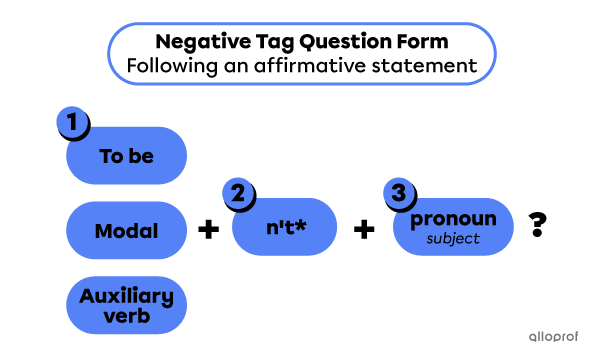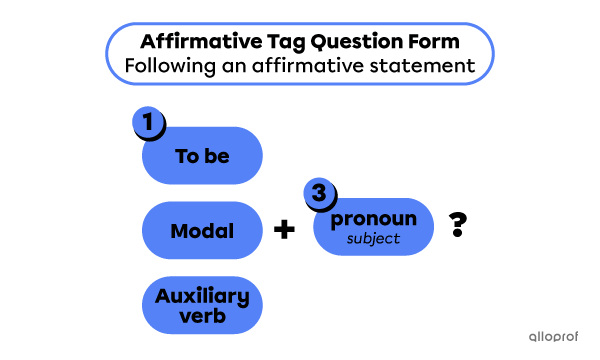Tag questions are short questions placed at the end of statements. Their purpose is to check if the listener agrees with the statement.
Affirmative statements are followed by negative tag questions.
|
Affirmative statement |
Negative tag question |
|
Annie is a scientist, |
isn’t she? |
|
You can fix the rocket, |
can’t you? |
Negative statements are followed by affirmative tag questions.
|
Negative statement |
Affirmative tag question |
|
Annie isn’t a scientist, |
is she? |
|
You can’t fix the rocket, |
can you? |
Tag questions are formed with 3 elements:
-
the verb to be, a modal or an auxiliary verb to indicate the verb tense
-
the function word not in negative tag questions
-
a pronoun indicating the verb subject.

*The contracted form for not is always used in negative tag questions.

|
Tag questions using to be |
|
|
The project is a lot of work, isn’t it? |
The project isn’t a lot of work, is it? |
|
We are on duty tonight, aren’t we? |
We aren’t on duty tonight, are we? |
|
This was a good idea, wasn’t it? |
This wasn’t a good idea, was it? |
|
Tag questions using modals |
|
|
The system should turn on, shouldn’t it? |
The system shouldn’t turn on, should it? |
|
Annie can help us fix it, can’t she? |
Annie cannot help us fix it, can she? |
|
A new computer would help, wouldn’t it? |
A new computer wouldn’t help, would it? |
|
Tag questions using auxiliary verbs |
|
|
Annie has fixed the problem, hasn’t she? |
Annie hasn’t fixed the problem, has she? |
|
You are panicking, aren’t you? |
You are not panicking, are you? |
|
We have been working efficiently, haven’t we? |
We haven’t been working efficiently, have we? |
|
Tag questions using no auxiliary verbs in the affirmative statement |
|
You write computer code, don't you? |
|
We solved the problem, didn’t we? |
|
Annie has a lot to finish, doesn’t she? |